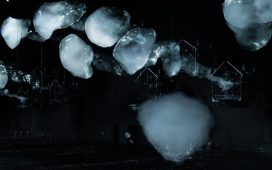islamic arts biennale complex hosts cultural journey
Over the past few weeks, Jeddah’s SOM-designed Western Hajj airport terminal has been transformed into a new cultural landmark as a backdrop for the inaugural Islamic Arts Biennale. Award-winning duo Giò Forma Architects and Black Engineering have teamed up to unveil the Biennale Complex — conceiving the space as a cluster of concrete volumes and voids centered around a serene water plaza to transport visitors through an evocative journey exploring Islamic heritage.
Fusing the past and present, the hosting complex sits in dialogue with its context while boldly expressing independence in its visual identity. Adopting the terminal’s grid layout at the basis of a new expression, the architects interweave the individual volumes throughout the space with sensitivity to both the site and the festival, seeking to ‘host and emphasize art, not to limit or overshadow it.’ Now open to the public, the Islamic Arts Biennale runs through April 23rd, 2023.

image © Marilyn Clark
giò forma & black engineering interweave past and present
Italian studio Giò Forma Architects and studio Black Engineering draw on the typology and ambience of the King Abdulaziz International Airport’s Hajj terminal — designed by Skidmore, Owings and Merrill (SOM) in 1981 — to devise their concept for the Islamic Arts Biennale Complex. The architectural design celebrates and translates the terminal’s harmonious dialogue between voids and volumes, depths and perspectives, unfolding as an exploration of contrasts, compositions, and materiality.
Further inspired by the modularity of the existing tent structures, the project is shaped by a series of individual volumes arranged in a dynamic composition that guides visitors on a rich journey through culture and history. Clusters comprising stacked geometric volumes of various sizes and proportions are configured in a rhythmic sequence, navigating the program into separate functions. The volumes create diverse galleries aimed at inspiring artists to interact with their spatial configurations, as seen by the extraordinary opening exhibition curated by DBF and OMA.

image © Marilyn Clark
a sequence of geometric volumes center around a water plaza
The structures center around a communal plaza characterized by a highly reflective body of water which exudes a touch of lightweight freshness and mirrors an ‘ethereal sense of contemplation across the space.’ The vertical reflection generates a new experiential dimension, dragging the eye further out to the horizon ‘in a dream-like abstraction of visual continuity’, establishing a monumental visual structure for the first Islamic Arts Biennale.
An innovative construction system shapes the Biennale Complex, based on high-tech pre-cast GRC panels constructed off-site and assembled on site. The facade reveals itself in minimalist expressions, punctuated by linear textures that alternate between solid panels and transparent lattices which filter light, create natural ventilation, and maintain visual connection between the indoors and outdoors.

view of the water plaza during dusk | image © Marilyn Clark

Biennale building and Hajj terminal reflecting in the water mirror | image © Marek Wolynski











